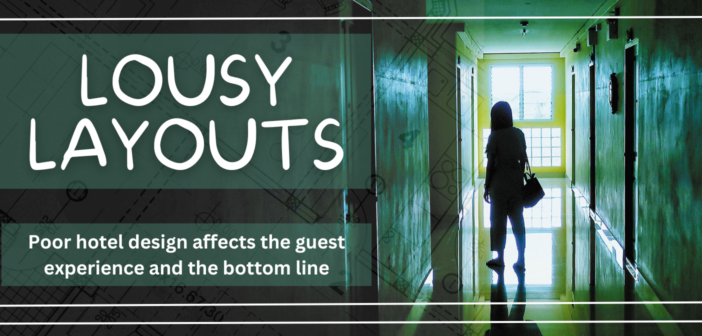Poor hotel design affects the guest experience and the bottom line
If you stay in hotels more than 200 nights a year, you’re bound to see some harshly lit spaces, and Tanya Spaulding has seen a bunch.
Spaulding, principal at Minneapolis-based Shea Design, said she’s on the road most of the year helping to design new hotels or renovate existing properties, whether it’s a boutique hotel or part of a major brand’s portfolio. Across the industry, she said, poorly lit spaces are “the biggest mistake” hoteliers make when designing guestrooms and common spaces – a correctable issue that affects the guest experience and the hotel’s bottom line.
“You need to light in zones and understand how people are moving through spaces,” Spaulding said. “You can’t have a harsh transition from one space to another. You need to create transitions between spaces through light, and you can do that very easily.”
Some hotels still have lights in guestrooms and bathrooms that are simply on or off and can’t be dimmed according to guests’ wishes, Spaulding said. Common areas such as lobbies and restaurants may be too bright or too dark for their intended function, making them less-comfortable spaces, and they may be uniformly lit throughout, failing to offer guests any flexibility, she said.

Similarly, harsh elevator lighting can make guests feel like they have a spotlight on them, and when the doors open, corridors can “feel very long and vast” if there’s too much or too little light, Spaulding said.
What’s the most-common lighting infraction? Spaulding said it’s definitely bathrooms that “aren’t appropriately lit at all” because they’re too bright, too dark, or make guests “look blue.” Installing backlit mirrors or even applying LED tape lights to the borders of mirrors can “soften” the lighting in a bathroom and make it more appealing to guests, she said.
Tom Ito, hospitality leader at the global architecture and design firm Gensler, said bathroom lighting should “make people look their best” instead of highlighting every blemish and wrinkle. Bathrooms with high-tech lighting-control systems that are difficult to use only add to the frustration, even if they’re meant to be more convenient, he said.
“You have to have the right light color and source to make people look good,” Ito said. “Your guests shouldn’t be asking why they look so green.”
Beyond lighting, there are many common design flaws that put hotels at a competitive disadvantage, according to Spaulding and Ito. While there are indeed many areas that can be improved aesthetically, here are areas where a little effort can go a long way in making a property look better.
1. GUESTROOMS
Most hoteliers know that a strong Wi-Fi signal is essential, but do your guestrooms have enough electrical outlets in the right places? Ito said guests want outlets next to each side of the bed so they can charge their smartphones, tablets, and laptops. With so many guests now working remotely, a good desk or table and a comfortable chair are vital, but don’t forget to put outlets there too, he said.
Built-in desks and closets may save space, but they make guestrooms less adaptable to guests’ changing preferences and needs, Spaulding said. Built-in closets typically have many drawers but, often, none of them are big enough to store a large suitcase and get it out of the guest’s way, she said.
Instead, many hotels are now choosing “open” closets that don’t have drawers, Ito said. Open closets give guests better access to their belongings and can enhance the aesthetics, he added.
“It’s a design statement that can be done very beautifully,” Ito said.

Typical guestrooms are small but, even so, commonly have “superfluous” furniture that rarely gets used, including tables, chairs, and couches, Spaulding said. Hoteliers may have a mental “checklist” of furniture items that should be in every guestroom, or they may believe that empty spaces hurt the aesthetics, but that approach often just leads to clutter, she said.
With less furniture in guestrooms, hotels can get creative with that extra space, according to Ana Ardon, global leader of Gensler’s hospitality practice. She said one hotel brand is installing so-called smart fitness mirrors – internet-connected devices allowing guests to take fitness classes in their rooms. The amenity targets a key segment of the brand’s client base – business travelers who want to stay fit on the road.
“It goes with the DNA of the brand,” Ardon said.
2. BATHROOMS
After solving the lighting issue, hoteliers should ensure guests have adequate space for their things, Spaulding said. Some guests will bring a large variety of toiletries and electrical devices to brush their teeth, shave, and style their hair, so they’ll need outlets in addition to counter space, she said.
Concerns over space are the main reason many hotels are eschewing bathtubs and instead focusing on providing a “great shower experience,” Ito said. To be environmentally friendly, many hotels have installed shower dispensers instead of providing small bottles of shampoo, conditioner, and body wash. But, some showers lack the shelf space for guests’ own toiletries, causing frustration, Spaulding said.
3. COMMON AREAS
Many properties are situating their bars near the main entrance so that arriving guests instantly feel like part of a community and are more likely to grab a drink, Ito said. In those cases, it’s best to locate the check-in process off to the side of the lobby. Otherwise, if multiple guests line up to check in, they could encroach on the bar area, diminishing the experience for those guests, he said.
Some lobbies were elaborately designed for a “wow effect” and to look beautiful in pictures, but if the lobby looks like one giant space, it can be uncomfortable for guests, Spaulding said. Partial walls, structural columns, indoor plants, seating arrangements, different levels of lighting, and other design elements can break up a lobby into many useable spaces, she added.
“No one wants to feel like they’re sitting in the middle of a room, so you need to create rooms within rooms,” Spaulding said.
The lobby should have areas where guests can sit down with a friend for a drink, attend a Zoom meeting, make a phone call, or read a book without feeling like they’re in a high-traffic area, Spaulding said. Furniture should be both beautiful and durable enough to withstand heavy use, and hard surfaces that reflect sound should be used sparingly in most cases.
Lobbies also should have some connection to the outdoors, whether through natural light or design features that “bring the outdoors inside,” Ito said.
To the extent possible, restaurants should be situated to facilitate outdoor dining, a popular trend ever since the pandemic greatly limited indoor dining, he said. If there’s enough space for a private dining room or meeting room, that can be another source of revenue. Restaurants should be able to accommodate parties of different sizes, and there should be several types of seating so guests don’t just see a “sea of identical chairs,” Ito said.
Long corridors should be broken up by indoor plants, artwork on the walls, or other design elements that reflect the local flavor and “some design intent,” rather than just a generic hallway, Ardon said.
Lastly, consider ditching your business center. People rarely need to print documents, and if they do, they should be able to send them electronically to the front desk or concierge, Spaulding said. Since multiple guest amenities often are located on the same floor, use that space to expand your fitness center, or make it available as a small meeting room, she said.

4. EMPLOYEE FACILITIES
Break rooms, locker rooms, cafeterias, and other employee areas often are shoehorned into layouts only after guest rooms and other revenue-producing areas have been designed, Ardon said. Hotels in urban settings often place employee facilities in the basement, which may prevent workers from enjoying natural light and fresh air on their breaks, she added.
Employee-only spaces often are cramped and inadequate, suggesting to workers that their comfort isn’t important to management. That’s the wrong message to send amid a persistent labor shortage, Ardon said.
“We’ve seen a lot of the brands actually upgrade their design standards [for employee spaces], so that has been amazing,” she said. “They’re asking us more and more to make sure there’s a thoughtful design process throughout those spaces because they want to make sure retention is high.”




